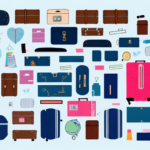How to Safely Ship Fragile Items
Shipping fragile items can be a daunting task, but with the right preparation and knowledge, it can be done successfully. In this guide, we'll cover everything you need to know about safely shipping fragile items, from choosing the right packaging materials to selecting the best carrier and tracking your shipment.
The Importance of Proper Packaging
Proper packaging is essential when shipping fragile items. It helps to protect the item from damage and ensures that it arrives at its destination intact. When packing a fragile item, it's important to consider the item's weight, shape, and fragility, as well as its destination and method of transportation. Here are some key packaging tips to keep in mind:
- Choose a sturdy box that is large enough to accommodate the item and padding materials.
- Use high-quality packing materials, such as bubble wrap, foam, or packing peanuts.
- Wrap the item in multiple layers of padding, and fill any empty spaces in the box with additional padding.
- Seal the box securely with tape, and label it clearly with “Fragile” and “This Side Up” markings.
It's also important to consider the environmental impact of your packaging materials. Opt for eco-friendly options, such as biodegradable packing peanuts or recycled cardboard boxes. Not only will this help reduce waste, but it can also improve your brand's reputation as a socially responsible company. Additionally, consider using minimal packaging materials whenever possible to reduce the overall weight and size of your shipment, which can help lower shipping costs and reduce your carbon footprint.
Choosing the Right Shipping Materials
When it comes to shipping fragile items, choosing the right materials can make a big difference in the item's safety and security during transport. Here are some key materials to consider:
- Boxes: Choose a sturdy, corrugated box that is appropriate for the size and weight of the item.
- Packing materials: Bubble wrap, foam, or packing peanuts can be used to provide cushioning and absorb shock.
- Tape: Use high-quality packing tape to seal the box securely and prevent it from opening during transport.
- Labels: "Fragile" and "This Side Up" labels are important for ensuring that the carrier handles the package with care.
It's also important to consider the environmental impact of your shipping materials. Opt for eco-friendly options such as biodegradable packing peanuts or recycled cardboard boxes. Not only will this help reduce your carbon footprint, but it can also appeal to environmentally conscious customers.
Another factor to keep in mind is the cost of shipping materials. While it's important to prioritize the safety of your items, it's also important to keep costs down. Consider buying materials in bulk or using alternative options such as shredded paper or old newspapers for cushioning.
Understanding Shipping Regulations for Fragile Items
When shipping fragile items, it's important to be aware of any regulations or restrictions that may apply. Depending on the type of item and the destination, there may be certain requirements or limitations that you need to follow. Here are some examples:
- International shipping: When shipping fragile items internationally, there may be restrictions on what can be shipped and how it must be packaged.
- Hazardous materials: Some fragile items, such as certain types of glass or electronic components, may be classified as hazardous materials and require special handling and shipping procedures.
- Insurance: Depending on the value of the item, you may need to purchase shipping insurance to protect it during transport.
It's also important to consider the fragility of the item itself. For example, delicate items such as ceramics or artwork may require extra padding or cushioning to prevent damage during transit. Additionally, it's a good idea to label the package as "fragile" to alert handlers to take extra care when handling the shipment.
Packing Tips for Fragile Items
When packing fragile items for shipping, there are several things to keep in mind to ensure their safe arrival. Here are some important packing tips to follow:
- Use sturdy boxes that are appropriate for the size and weight of the item.
- Wrap the item in multiple layers of padding, such as bubble wrap, foam, or packing peanuts, to provide cushioning and absorb shock.
- Fill any empty spaces in the box with additional padding to prevent movement during transport.
- Seal the box securely with high-quality packing tape.
It is also important to label the box as fragile to ensure that it is handled with care during shipping. Additionally, consider purchasing shipping insurance to protect your item in case of damage or loss during transport. Finally, if you are unsure about how to properly pack a fragile item, consider consulting with a professional packing and shipping service for guidance.
How to Choose the Right Carrier for Fragile Items
Choosing the right carrier is an important part of safely shipping fragile items. Here are some key factors to consider:
- Experience: Look for carriers that have experience handling fragile items.
- Services: Consider carriers that offer extra services, such as handling and tracking.
- Cost: Compare shipping rates from different carriers to ensure you get the best deal.
- Insurance: Check if the carrier offers shipping insurance or if you need to purchase it separately.
Another important factor to consider when choosing a carrier for fragile items is the packaging. Make sure that the carrier has specific packaging requirements for fragile items and that they provide adequate packaging materials. You can also consider using a carrier that offers packaging services to ensure that your fragile items are properly packed and protected during transit.
Cost-Effective Ways to Ship Fragile Items
Shipping fragile items can be expensive, but there are ways to save money while still ensuring the items arrive safely. Here are some cost-effective ways to ship fragile items:
- Use flat-rate boxes: Flat-rate boxes from the USPS can be a cost-effective option for shipping fragile items.
- Compare rates: Compare rates from different carriers to find the best deal.
- Use smaller packages: If the item is small enough, packaging it in a smaller box can help reduce shipping costs.
- Use standard shipping: Standard shipping options can be more affordable than expedited or express shipping, but may take longer.
Tracking Your Shipment: Best Practices
Tracking your shipment is important for ensuring that your fragile item arrives at its destination on time and in good condition. Here are some best practices for tracking your shipment:
- Choose a carrier that offers tracking services.
- Keep your tracking number and shipping information in a safe place.
- Set up notifications for updates on your shipment's status.
- Monitor your shipment's progress regularly, and follow up with the carrier if there are any issues.
What to Do When an Item Arrives Damaged
Despite your best efforts, sometimes a fragile item may still arrive damaged. Here's what to do if that happens:
- Document the damage: Take photos of the damaged item and its packaging to document the extent of the damage.
- Contact the carrier: Contact the carrier as soon as possible to report the damage and file a claim.
- File a claim: Fill out a claim form and provide supporting documentation to the carrier to request reimbursement for the damaged item.
Shipping Insurance: What You Need to Know
Shipping insurance can provide added protection for fragile items during transport. Here are some key things to know about shipping insurance:
- Not all carriers offer shipping insurance, so you may need to purchase it separately.
- Insurance rates may vary depending on the item's value and the carrier's policies.
- Be sure to read the terms and conditions of the insurance policy carefully to understand what is covered and what is not.
International Shipping Considerations for Fragile Items
When shipping fragile items internationally, there are several additional considerations to keep in mind. Here are some examples:
- Customs regulations: Different countries have different customs regulations, so it's important to do your research before shipping an item.
- Packaging requirements: Some countries may have specific packaging requirements for fragile items, such as using certain materials or labeling the box in a certain way.
- Taxes and tariffs: International shipments may be subject to taxes and tariffs, which can vary depending on the item and the destination country.
Common Mistakes to Avoid When Shipping Fragile Items
There are several common mistakes that people make when shipping fragile items. Here are some examples:
- Using inadequate packaging materials.
- Overstuffing the box or leaving too much empty space inside.
- Not properly sealing the box with tape.
- Not labeling the package as "Fragile" and "This Side Up."
Tips for Shipping Glassware, Electronics, and Other Delicate Items
Shipping fragile items like glassware, electronics, and other delicate items requires extra care and attention. Here are some tips to help keep these items safe during shipping:
- Use specialized packaging materials, such as foam inserts or custom boxes, to ensure a snug fit.
- Wrap delicate items in additional layers of protective padding.
- Consider using double-boxing to provide extra cushioning and protect against impact.
- Label the package as "Fragile" and "This Side Up" to ensure proper handling.
Safe Handling and Transport of Fragile Items
In addition to proper packaging, safe handling and transport are also important factors in protecting fragile items during shipping. Here are some tips to ensure safe handling and transport:
- Store packages in a secure, stable location during transport to prevent shifting and sliding.
- Handle packages with care during loading and unloading.
- Use appropriate lifting and carrying techniques to minimize the risk of dropping or damaging the package.
- Use caution when opening packages to avoid damaging the contents.
How to Pack and Ship Oddly Shaped or Oversized Fragile Items
Packing and shipping oddly shaped or oversized fragile items requires extra planning and effort. Here are some tips to help you successfully pack and ship these types of items:
- Use custom packing materials, such as foam inserts or specially designed boxes, to fit the item's unique shape.
- Consider disassembling the item if possible to make it easier to pack and ship.
- Label the package with clear instructions for handling and orientation.
- Use a carrier that specializes in handling oversized or fragile items.
Conclusion
Shipping fragile items can be challenging, but with the right preparation and knowledge, it can be done safely and successfully. Whether you're shipping glassware, electronics, or other delicate items, following the tips and guidelines in this guide can help ensure a smooth and stress-free shipping experience. Remember to choose the right packaging materials, select the best carrier, track your shipment, and take precautions to ensure safe handling and transport. With these best practices in mind, you can ship your fragile items with confidence.






















